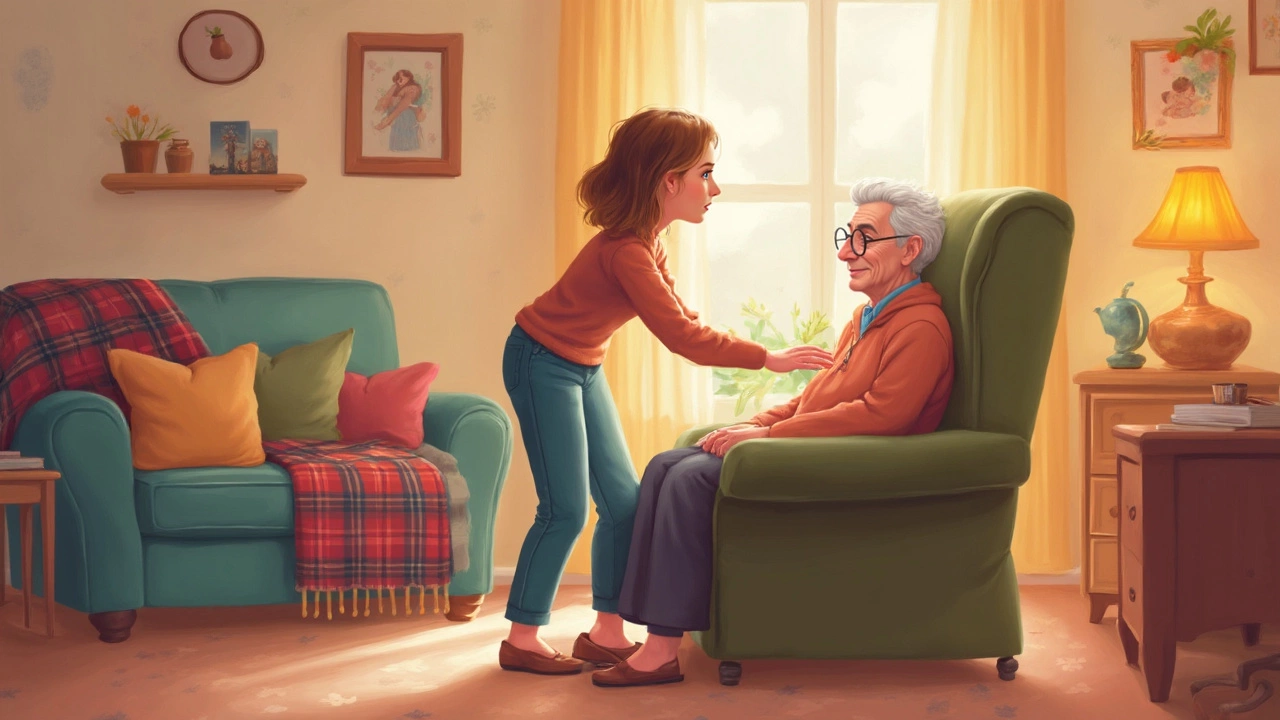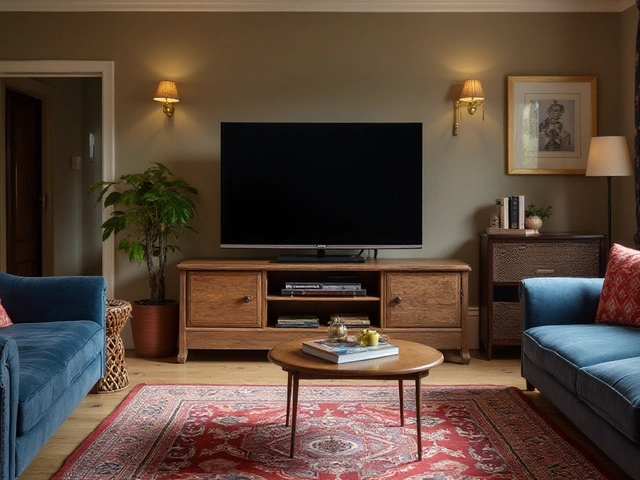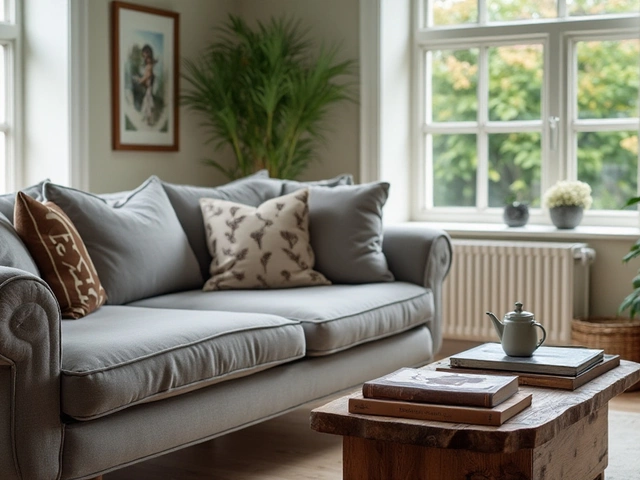Ever peek into the living room and see your mom or granddad half-slid down in their recliner? It's more common than you think. For many seniors, staying upright in a cozy chair isn't as easy as it looks. The real problem? Weak core muscles and a too-slippery seat turn that plush recliner into a slow-moving slide.
Good news—you don’t need a fancy gadget or professional help right away. Before heading to the store for pricey solutions, check the basics: Is the chair too big? Are their feet dangling? Sometimes, the easiest fix is the most obvious—like swapping out a loose, shiny blanket for a textured lap mat or a non-slip cushion. Even small tweaks make a surprising difference.
- Why Older Adults Slide Down Recliners
- Simple Adjustments You Can Try Today
- Smart Tools and Accessories that Actually Help
- Picking the Right Recliner for Seniors
- Tips for Everyday Comfort and Safety
Why Older Adults Slide Down Recliners
Ever notice how your loved one starts off sitting tall in their recliner chair and ends up slouched halfway down? There are a few reasons behind this—and they’re pretty straightforward.
Elderly safety often runs into trouble because of weak core muscles. As we age, our abs and back just don’t keep us upright like they used to. This makes it super easy to slide down slowly, especially on smooth or overstuffed chairs.
Another common factor is arthritis or joint stiffness. If moving hurts, seniors sometimes pick positions that feel less painful at first, but aren’t so safe or comfortable in the long run. Plus, if their feet don’t reach the floor, they can’t “anchor” themselves, which increases sliding even more.
Slippery fabrics don’t help either. Leather and some synthetic covers feel great, but they don’t give much grip. Add on gravity and you’ve got a recipe for slow sliding—especially when folks fidget, nap, or try to adjust themselves without much leg strength.
| Reason | How it Contributes |
|---|---|
| Weak Core Muscles | Can't hold upright posture for long periods |
| Slippery Seat Material | No grip to keep the body in place |
| Feet Can't Touch Floor | No leverage to push against sliding |
| Joint Stiffness or Pain | Difficult to reposition or correct posture |
Let’s not forget medications. Some meds can make people drowsy or dizzy, which means less body control and more risk of ending up slouched in the recliner chair. Put all this together, and you’ll see why sliding happens way more for older adults than younger folks watching TV in the same spot.
Simple Adjustments You Can Try Today
If your elderly loved one keeps sliding down their recliner chair, don't panic—there are super practical changes you can make right now. No need to call in a handyman just yet. Most fixes take only minutes to try, and they’re easy on the wallet.
Start by checking the fit of the chair. If the senior is shorter, their feet might not touch the ground, which makes sliding way more likely. Place a sturdy footrest or stack of books in front of the chair to let their feet rest flat. You can even find adjustable foot platforms online for less than the cost of a pizza night.
Next, rethink the surface of the seat. Smooth leather or cloth makes sliding so much worse. Swap out any loose cushions for a firm, non-slip seat pad. No fancy shopping required—a rubberized bath mat (clean, of course) does the trick for lots of folks. You can buy non-slip chair pads made just for elderly safety at most home stores.
How’s their posture? Sometimes, a simple roll cushion or a rolled-up towel against the lower back helps the person sit more upright. This gives their back some grip and keeps their bottom from creeping forward over time.
Here’s a quick checklist to run through when trying to improve recliner comfort for sliding:
- Check seat depth: add back pillows if the chair is too deep.
- Adjust foot support: use a footrest to let feet touch the ground.
- Add a non-slip surface: use chair pads or grippy mats.
- Remove slippery throws and smooth blankets from the seat.
- Encourage upright sitting by propping a cushion behind the lower back.
If you try these and sliding keeps happening, you might need to look at sturdier assistive products or think about upgrading to a more supportive recliner chair that's really made for senior comfort.
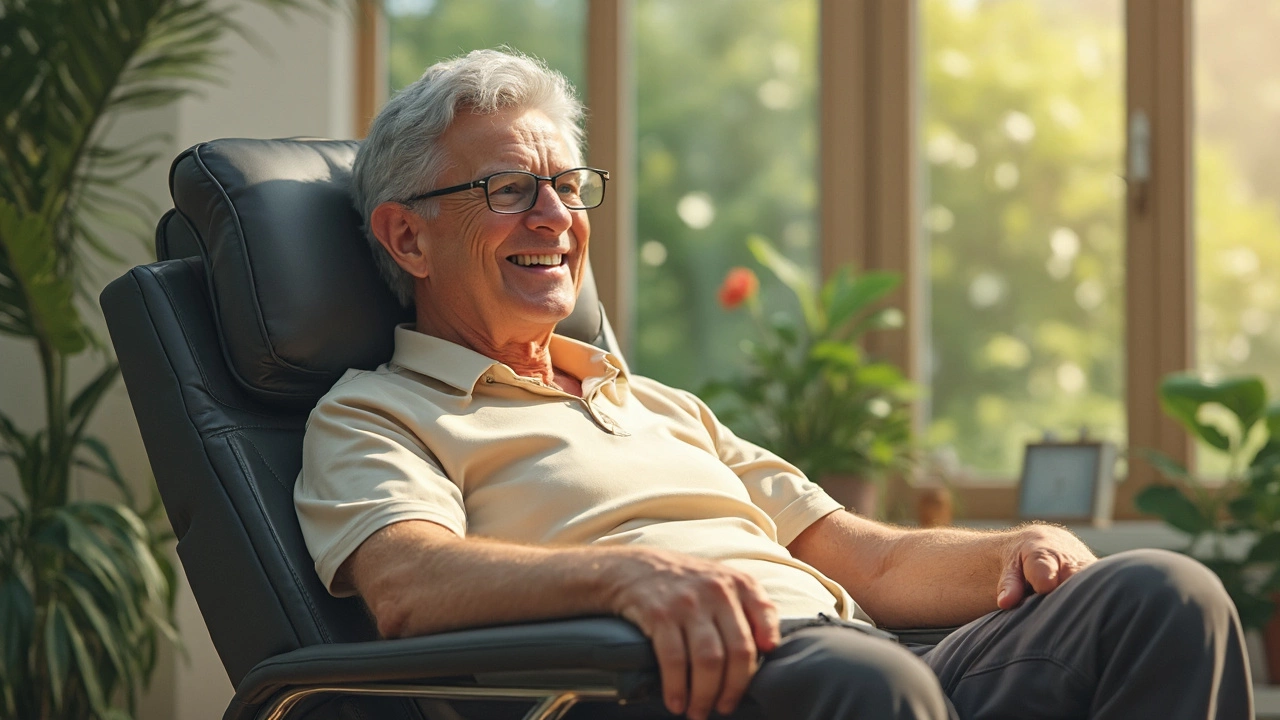
Smart Tools and Accessories that Actually Help
Trying to keep someone from sliding down in a recliner chair? There's more than just stuffing pillows behind their back. Some simple gear really does make life easier, and lots of these add-ons cost less than dinner for two.
The first thing people try is a non-slip cushion. These are special seat pads with a grippy underside (think yoga mat material) that stick to both leather and fabric. They don't budge when folks move around. Look for brands like Secure, Rose Health Care, or Posey—they're popular because they simply work.
Another effective fix is a recliner safety belt. It's not as scary as it sounds. Most just gently loop around the waist or hips, snap closed like a car seatbelt, and add that extra nudge to stay upright. These are usually padded for comfort and easy to remove. Some styles can be tucked away when not in use, so you’re not turning the living room into a hospital room.
For people with less strength in their legs, adding a solid footrest extender levels things out and gives their feet a steady spot to rest. This helps because feet dangling off the edge often start a slow slide down. Look for models that fit your specific recliner—universal extenders usually work for most chairs.
Lap blankets and shawls can be slippery, but a non-slip lap pad can give the cozy feeling without any slipping. These pads have grippy fabric on one side to stay put on the seat.
Some families also use side bolsters—padding that keeps someone centered in the seat. This is extra helpful if your family member leans a lot to one side or always shifts in their chair.
Real talk from the pros:
"When we added non-slip pads and a footrest extender to my mom's recliner, the problem pretty much disappeared. Small changes made a big difference." — Occupational therapist Jessica Martin, via AARP
Here's a quick rundown of tools and their main benefits:
| Accessory | Main Benefit | Rough Price Range (USD) |
|---|---|---|
| Non-slip Cushion | Reduces sliding on all surfaces | $20–$40 |
| Safety Belt | Adds gentle security | $15–$35 |
| Footrest Extender | Supports feet, fixes posture | $30–$60 |
| Side Bolsters | Keeps person centered | $25–$50 |
| Non-slip Lap Pad | Prevents sliding forward | $18–$35 |
No one tool solves everything, but a couple of these together take care of the majority of elderly safety issues in recliners. If you mix and match, you'll hit that sweet spot where comfort and safety really do go hand in hand.
Picking the Right Recliner for Seniors
Not all recliners are built with seniors in mind. If you want to really prevent sliding and bumps, you’ve got to look at more than just style or price. Look for recliner chair models that tick some key boxes—because small design details make a big difference for elderly safety and comfort.
The biggest game-changer? Chair size and fit. If the seat is too deep, older adults slide forward trying to keep their feet on the floor. Aim for a recliner with a seat depth of 19-21 inches—most folks in their 70s and 80s find this comfortable and safe. The chair’s height also matters: when sitting, feet should rest flat on the ground, and knees should form a right angle.
Another thing to check: the fabric. Leather and slick vinyl look cool but can be slippery. Durable, grippy fabrics like textured polyester or microfiber actually help prevent sliding prevention issues. Some brands even offer anti-slip seat options or add-on kits if you ask.
- Armrests: Look for sturdy, padded armrests—they help with standing up and make getting out way easier.
- Lumbar Support: Good recliners have built-in lumbar support to keep posture upright and reduce slumping.
- Zero Gravity Models: These distribute weight evenly, which cuts down on pressure points and keeps seniors from sliding.
- Electric Lift: If your loved one struggles to get up solo, look at power lift recliners. They tilt forward safely and prevent the "slump and stand" problem.
Check the chair’s weight rating, too. Most standard recliners support up to 250-300 pounds, but bariatric models are made for heavier folks and don’t trade stability for size.
If you’re still shopping, it’s worth testing a few floor models with your loved one present. Bring a friend or family member, watch how they sit and stand—does the recliner keep them upright, or do they instantly start sliding? Trust your eyes and gut before you swipe the card; comfort and senior comfort matter way more than any feature list on paper.
| Feature | Helps Prevent Sliding? |
|---|---|
| Textured Fabric | Yes |
| Deep Seat | No |
| Power Lift | Yes |
| Adjustable Footrest | Yes |
| Leather | No |
The right chair sets the stage for everything else—safer transfers, better posture, and peace of mind for both you and your loved one.
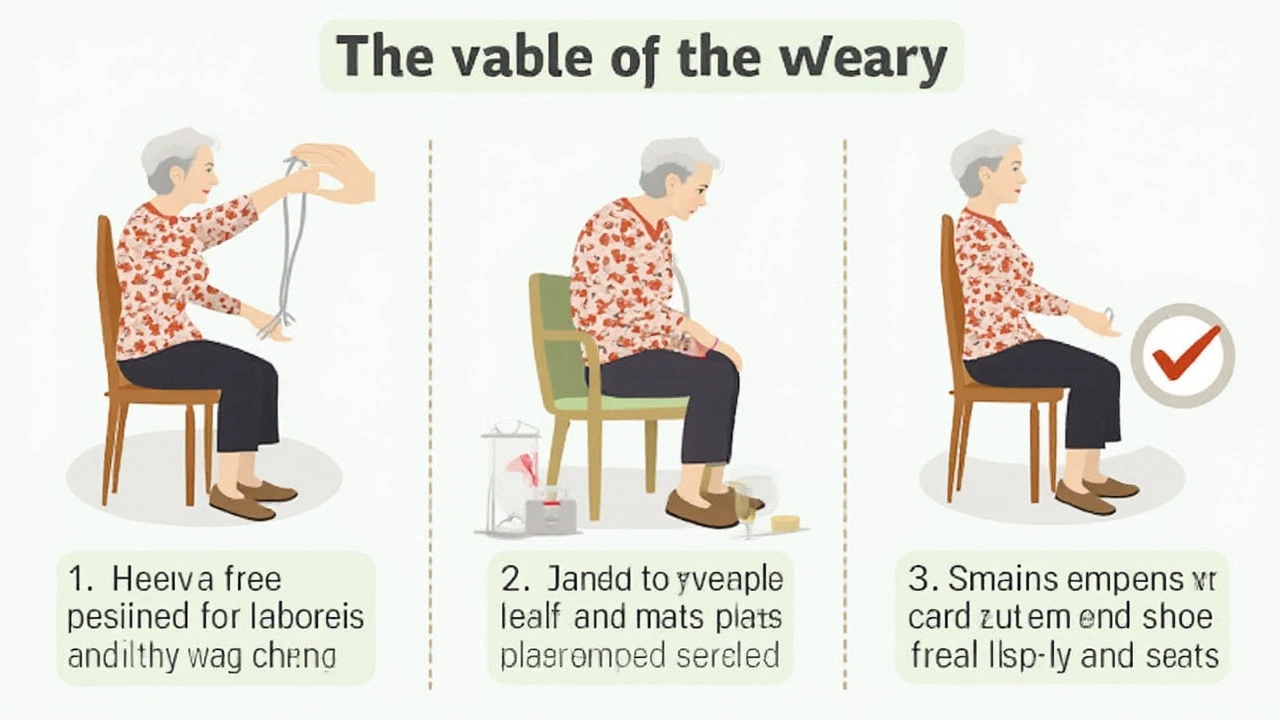
Tips for Everyday Comfort and Safety
Daily habits can make a world of difference when you’re trying to keep your loved one from sliding down their recliner chair. It’s not just about buying the right gear—sometimes the small stuff works best. Here’s what you can do each day to boost elderly safety and keep that recliner working for them, not against them.
- Foot placement is key. Make sure their feet can touch the floor comfortably when sitting. Chairs set too high often cause sliding, since nobody’s legs dangle comfortably for long. If your recliner is tall, try adding a sturdy footrest.
- Encourage shifting and breaks. Remind them (gently, of course) to adjust their position every so often, or even stand up for a stretch during TV commercials. Long periods of sitting add to the risk of sliding and discomfort.
- Keep the essentials nearby. Place the remote, reading glasses, snacks, and water within arm’s reach. No need for risky leaning or shifting if everything’s close at hand.
- Use a non-slip cushion. You can buy seat pads made to grip the fabric and hold people steady. Some have light straps to stay in place, and they’re machine washable, too.
- Check the angle of the backrest. Too far reclined? That actually makes sliding worse. The safest setting for most seniors is a middle ground—just enough recline to relax, but not so much gravity takes over.
Hydration matters, too. Dehydrated people might feel weaker and less stable, even in a comfy recliner chair. Make sure they’re drinking enough water, especially if your place runs warm.
Want some numbers? Studies from the National Institute on Aging say over 40% of adults over 65 deal with some kind of sitting discomfort daily—and half of those folks say it messes with their sense of balance. This shows that simple tweaks at home really do help reduce risks and make senior comfort way better.
Lastly, check on chair condition about once a month. Worn-out foam or broken parts ramp up sliding even in the best setup. Quick monthly checks stop small problems before they turn into big falls. Your loved one’s comfort and safety are worth the few extra minutes.
